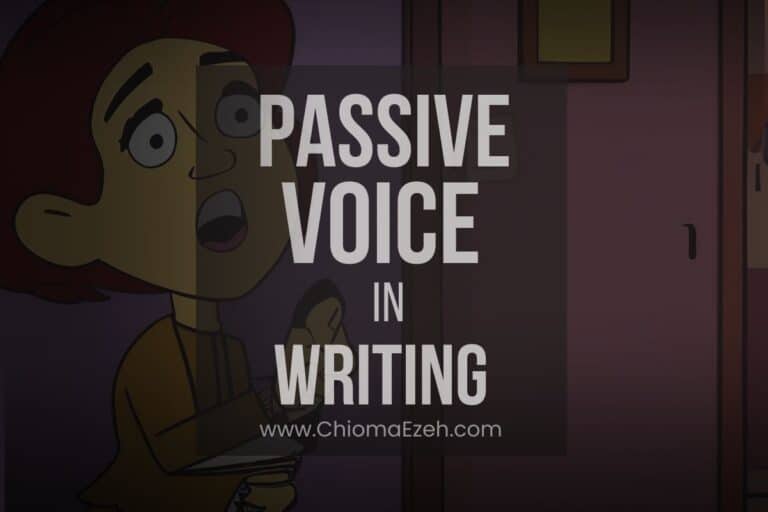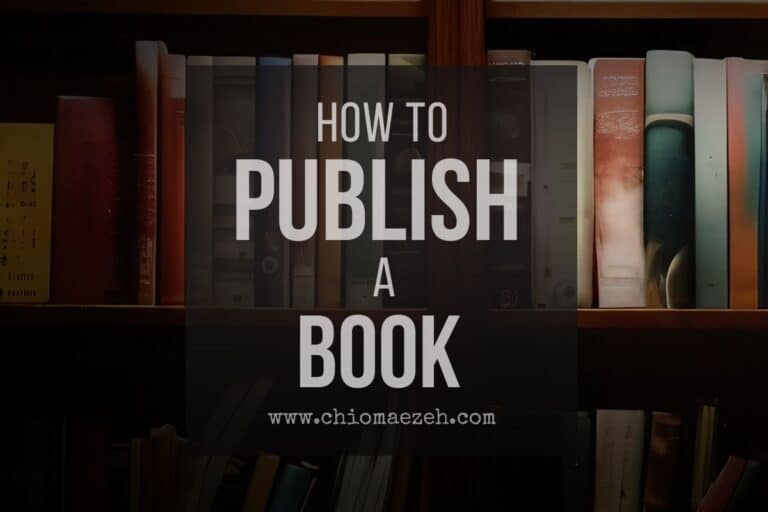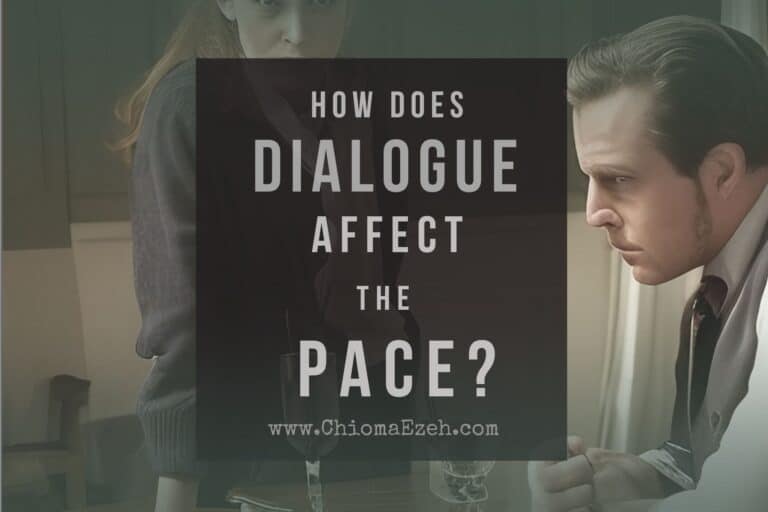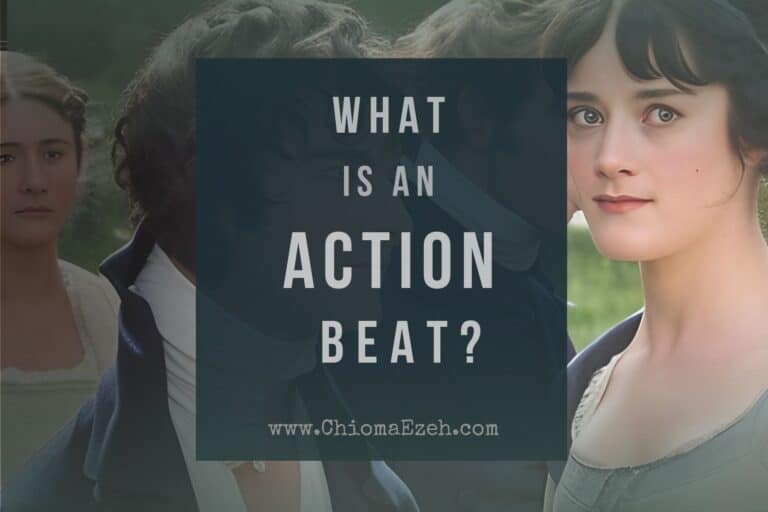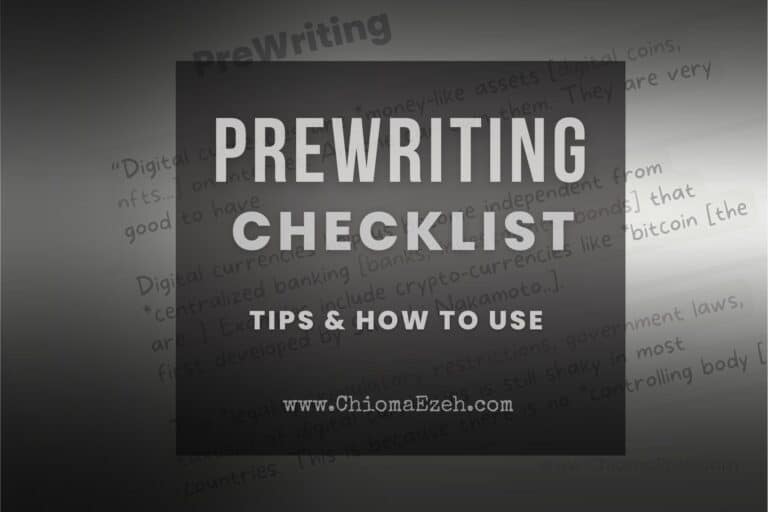How To Write A Book Description That Sells On Amazon In 2023
Writing can be intimidating. Even worse, writing and publishing a book can be more daunting, especially if you’re new.
The publishing game has changed in 2023. Many old strategies no longer work, and it’s easy to get trapped in old methods that have become outdated.
Book descriptions are not left out. Amazon now considers some old methods as violations. So, you don’t want to make mistakes that could cost you valuable book sales or even your publishing account.
This is a comprehensive guide for both fiction and non-fiction publishing. If you’re specifically looking for just non-fiction book description, then check out this post “How To Write A Book Blurb For Non-fiction: 5 Key Elements that Sells Your Book.
In this article, we’ll find out what an amazon book description is, and why it matters, as well as discuss how to write an Amazon book description. I’ll offer some tips and tricks for honing your Amazon book description-writing skills, as well as provide a few examples of both successful and bad book descriptions.
I’ll also provide some templates you can model after, and start seeing sales immediately, so stick till the end.
Let’s get to it!
Related: See Our Guide on How to Publish A Book On Amazon where we discuss tips and tricks to getting your first book live in hours
Let’s Talk
Are you a writer aspiring to pen a masterpiece that never fails to captivate? Look no further. Reach out to us and uncover how we can help you to take your writing to unprecedented heights!

What Is A Book Description?
A book description (sometimes called the blurb) is a short summary of the storyline or content of a book. It is typically found on the back cover or inside flap of a hardcover book, and at the beginning of an ebook. It can also be found on the sales page of the retailer’s website such as Amazon.com or Goodreads.
Book descriptions are used to give readers an idea of what to expect from reading the book and may include elements such as genre, setting, plot summary, major themes
Why Does a Book Description Matter?
Book descriptions matter because they help people decide if they want to read your book. It tells them “why” they should get your book, and not just “what the book is about”. In other words, your book description is not a summary or an overview. It is a sales page – a landing page
A good description can make a book popular and help get people to want to buy and read it. It can also help create a positive buzz around the book. Take, for instance, the Harry Potter series. Without the detailed description of Hogwarts, and all the magical wonders, who would have been intrigued to read about Harry Potter?
There is a door at the end of a silent corridor. And it’s haunting Harry Potter’s dreams. Why else would he be waking in the middle of the night, screaming in terror? It’s not just the upcoming O.W.L. exams; a new teacher with a personality like poisoned honey; a venomous, disgruntled house-elf; or even the growing threat of He-Who-Must-Not-Be-Named. Now Harry Potter is faced with the unreliability of the very government of the magical world and the impotence of the authorities at Hogwarts. Despite this (or perhaps because of it), he finds depth and strength in his friends, beyond what even he knew; boundless loyalty; and unbearable sacrifice.
Harry Potter and the Order of the Phoenix – By J.K. Rawlings
Author J.K. Rowling gave us such an exciting description that it left readers wanting more! The description is so engaging that it has become one of the most popular book series of all time. It doesn’t just tell readers what the story is about, but also sets the scene and creates an atmosphere that draws people in.
So, this means book descriptions are important for marketing purposes. I’ve seen many books that have wonderful stories but failed to intrigue a potential reader due to a lack of an engaging copy.
Does Book Descriptions Matter On Amazon?

Book descriptions are necessary for online retailers like Amazon. While the cover and title of a book may catch a reader’s attention, the description seals the purchase deal.
Imagine being able to write a well-crafted book description that persuades readers to click “buy.” Your Amazon book description can be the difference between your book’s success and failure.
I’ve come across scores of Indie authors who struggled with book sales. However, once they tweaked their book descriptions, sales significantly improved.

Here are reasons why a book description matters on Amazon:
- Helps your book stand out: Your book description helps to differentiate your book from others in your genre and gives readers an idea of what they can expect from the story.
- Advertises your book: It is a great way to inform potential readers of the features and benefits your book offers and why they should choose yours over other books in the same genre.
- Creates an emotional appeal: A good book description helps create an emotional connection with potential readers and nurtures the journey that leads them to buy your book.
- Improves sales: A well-written book description entices potential readers to buy to learn more
- Helps you build your brand: A book description is also an excellent opportunity to introduce yourself to readers and establish your brand as an author.
Can Indie Authors Benefit from Book Descriptions?
While there are a growing number of publishing services and modern tools, apps, and devices, to make writing and publishing easier, the game is getting more competitive for indie authors. One thing I have come to realize that that there are still glaring gaps to be filled in most genres with regard to crafting book descriptions.
To fill in these gaps, you have to come to the game, with your unique authentic voice, and tone that will really capture and endear you to your audience. This is part of your unique value proposition. And it is one element of brand-building.
The kind of voice you use for your book description is key to your book’s success. Your voice must be heard through your copy. And that’s because selling on Amazon requires more than just a good story or content — you have to know how to craft an engaging copy that will draw readers in.
So what makes a good copy? What makes a good book description?
What Makes A Good Description?
To write a book description that sells, you should know what makes a good description. Here are a few key points you should keep in mind while writing a “good” description:
#1. A Good Book Description has a hook:
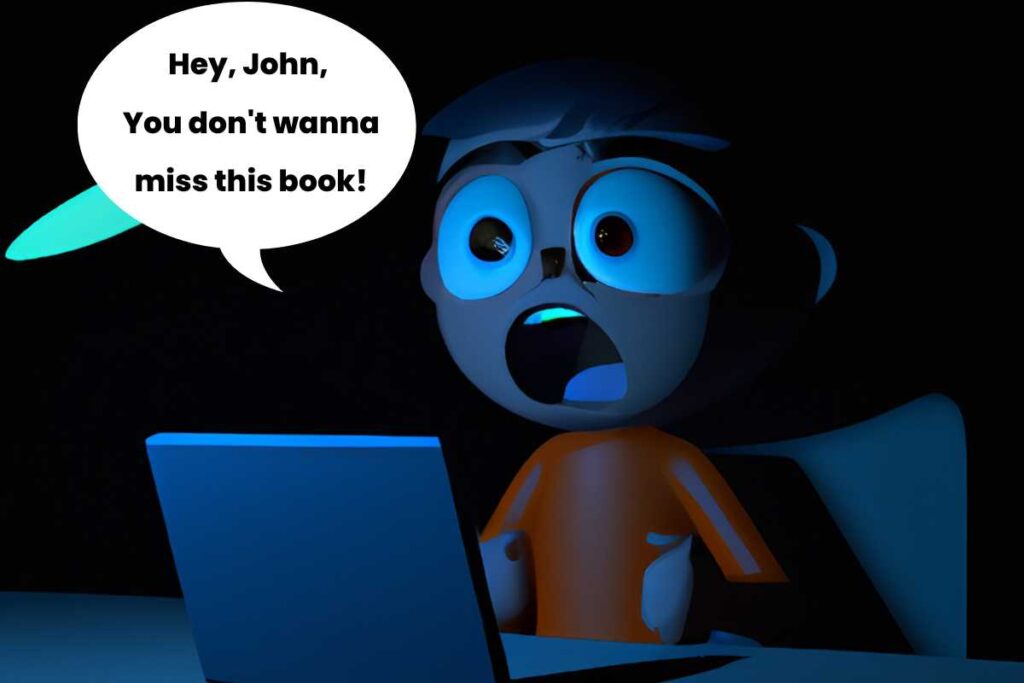
A hook is a catchy phrase or sentence intended to capture the readers’ attention. A good book description always begins with a catchy sentence that captures the readers’ attention and compels them to read the whole narrative.
You should always give your book description a hook to attract and keep attention.
#2. It has relevant statistics:
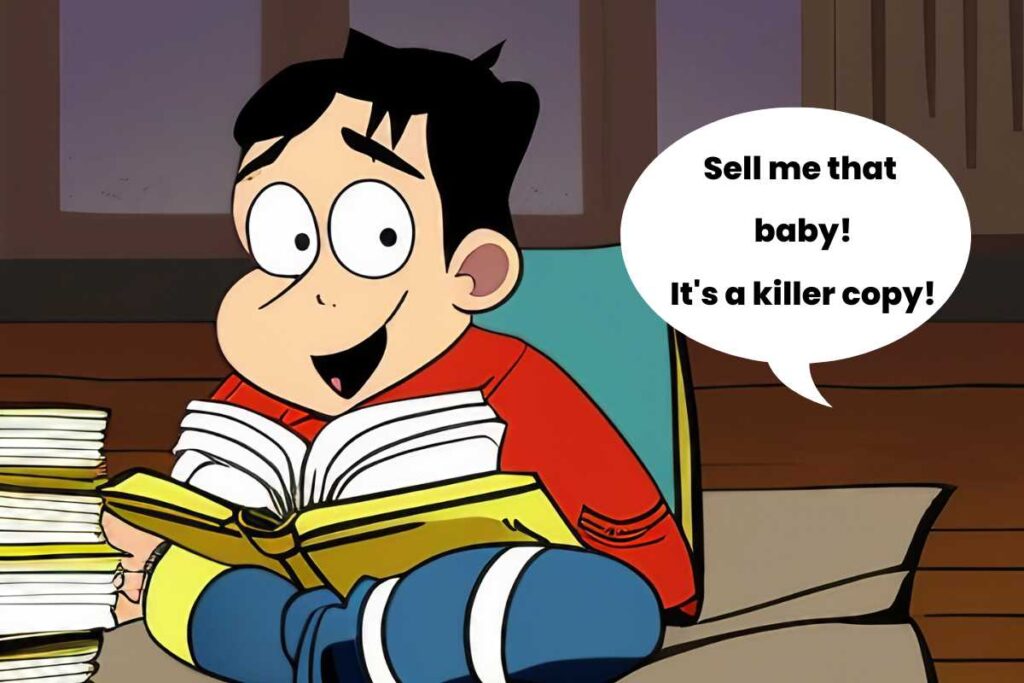
Adding statistics or other facts to your book description can help it sound more trustworthy. Let’s say your book is based on analysis or has case studies; noting it in your description can get people to trust and buy your book
#3. It Uses Clear Language:

Your book’s description is its sales copy. It should compel readers to purchase the book. You should always use clear, concise language to highlight the benefits and value that readers will get from the book.
#4. It appeals to the reader’s emotions:
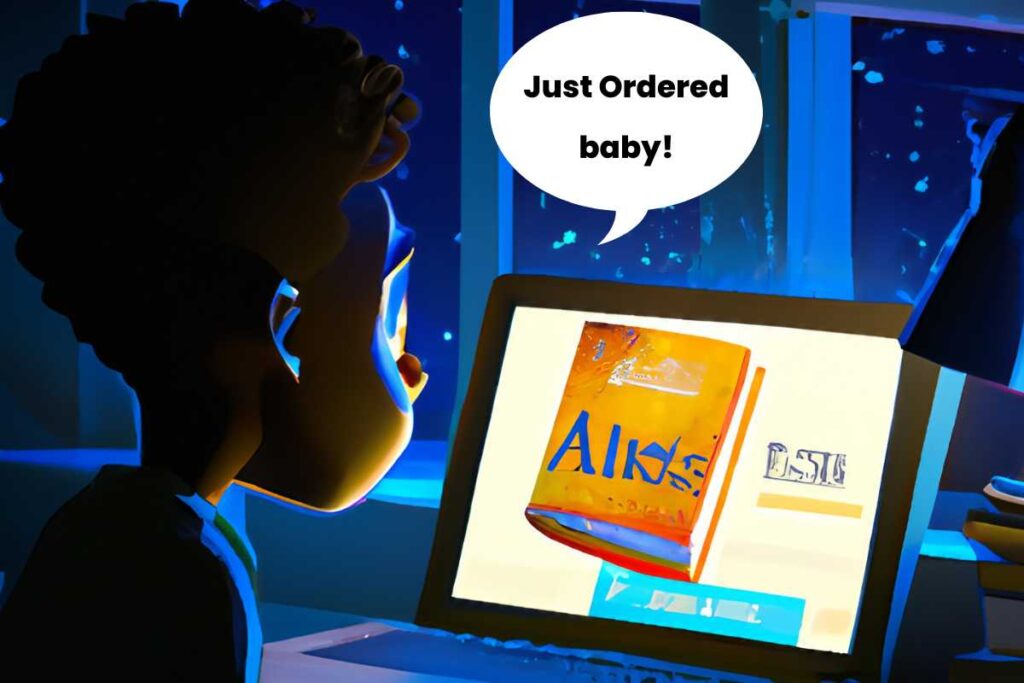
Your book description should appeal to readers’ emotions. This is a powerful way to persuade them to buy your book. You could use “power words” to convey specific messages that’ll trigger them to the buy button.
#5. It is short and to the point.
Your book description should be concise and to the point. It should focus on your book’s most relevant details. Oftentimes, it is standard practice to highlight these points in bulleted list format.
Recommended Readings
How To Write A Book Description That Sells On Amazon
I’ve tried several methods of writing my book descriptions on Amazon, and I’m about to share what works. This method has helped me sell thousands of copies of my books on Amazon.
This tutorial will discuss how to write a book description at length.
We will also analyze the key ingredients I often incorporate into my book’s description that almost always guarantee sales.
I’ve broken down the process into 7 actionable steps:
- Identify the Key Points or Theme of Your Book
- Start With a Strong Opening Line to Grab Readers’ Attention
- Concisely Describe What the Book is About
- Highlight the Unique Selling Point of Your Book
- Use Bullet Points to List Key Features of Your Book
- Build Authority
- End With a Strong Call-to-Action
#Step 1: Identify the Key Points or Theme of Your Book

When you identify your book’s key points, you’ll be able to create a description that accurately reflects its content or story. However you plan to choose the points, they must convey value to readers.
The 3W Questions
To identify your book’s key theme, ask yourself the 3W questions.
- What is the main point or message in your book?
- What ideas does your book revolve around?
- What benefit does your book provide?
By answering these 3W questions, you’ll know exactly the key points to highlight in your book’s description.
Charles Duhigg’s The Power of Habit’s Amazon book description is a great example of how to craft a book description after answering those three questions:

As you can see, the second sentence (line) reads:
“This instant classic explores how we can change our lives by changing our habits”
This promptly summarizes what the reader expects to get in ONE sentence. And this reiterates the first question “What is the main point or message you want to get across in your book?“
See that?
The first 5 sentences in the body of the description capture the second question, “What ideas does your book revolve around?”
And then the last question “How can your book benefit your readers? is established in the last two sentences of the body.
The key to exercising regularly, losing weight, being more prodcutive, and achieving success is understanding how habits work. As Duhigg shows, by harnessing this new science, we can transform our businesses, our communities and our lives”
That’s how you identify and summarize the critical points of your book in your book description. So yes, start by answering these fundamental questions.
Recommended Readings
- How to Identify Theme in a Literary Work by ThoughtCo
- What Are Some Ways You Can Identify the Theme of a Book – A Quora Thread
Step 2: Start With a Strong Opening Line to Grab Readers’ Attention

Try to write a compelling opening line for your book description. You can:
- Use a provocative statement, a question, or a statistic
- Start with a review, quote, or an honor – like a book award
- Convey the most compelling idea of your book
Let’s see a few examples: Here is an example from Richard Osman’s The Thursday Club below:

Notice how he grabbed attention in the opening line? Who wouldn’t want to read a book that would soon be adapted into a movie? He also advertises his “authority” with the “A New York Times Bestseller” phrase.
Again, I bet you’d loved to read a bestseller – even more, one that would soon be in film from Steven Spielberg himself. He did this to gain readers’ trust.
Below is another example from John Axe’s Keto Diet

John started with the “authority” line and then moved on to convey the most compelling idea of his book. That aside, you can see the three questions accurately capture in that single sentence vis-a-vis:
- What is the main point or message? [30-day Healthy plan]
- What ideas does your book revolve around? [80 Delicious recipes]
- What benefit does your book provide? [To burn fat, fight inflammation, and reverse disease]
Again, here is another example from Rina Kent’s Empire of Sin.
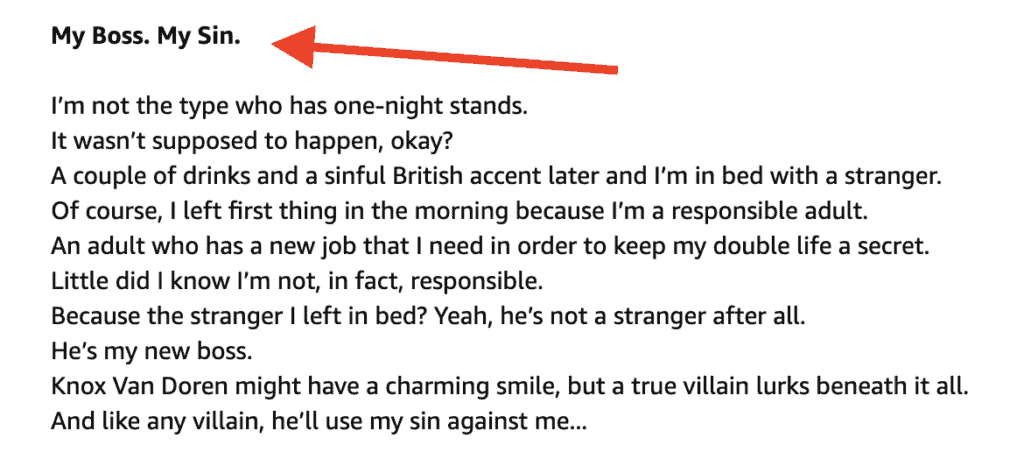
This is one of the simplest book descriptions I have ever come across – yet this book sells thousands of copies monthly. See the hook – four words, two sentences, and one idea. I remember when I first started writing my book descriptions. I’d spend hours trying to tweak and get the perfect copy, but I still didn’t succeed.
Not until I went back to the basis. I realized the KISS principle (Keep It Stupidly, Simple) works better with book descriptions. When you realize that our attention span as humans is getting shorter by the day, you’ll appreciate this fact.
I decided to keep it simple. And so, I came up with a template that is so simple but works. So, the thing is, do not get overwhelmed. Just stick to the basics. Ask the 3W questions, and you’ll get it right.
Recommended Readings
- East Stroudsburg University’s Guide to Writing a Hook
- Gallaudet University’s Guide to Writing Introductions
Step 3: Concisely Describe What the Book is About

Once you’ve written a strong opening line, it’s time to describe your book in one or two paragraphs. Here is what you should do:
- Take your book’s main idea/theme/key point and describe it most persuasively.
- Keep this section scannable by cleverly using “underline”, “bold”, and other formatting features.
- Your main idea must address your reader’s pain point if your book is non-fiction. If it’s fiction, you must target the main point of conflict in your book
Let’s see a few examples: Below is one from John Axe’s Keto Diet book

He described the main takeaway while targeting the readers’ pain points. Again, another example from Rina Kent’s Empire of Sin

Notice the main conflict point? He was able to capture the key details in a few lines
Key Takeaway:
When I first started self-publishing, I often needed to correct mistakes in my book descriptions. One common issue was using too many words and generic language. But I learned that solid and specific terms and a sense of urgency could effectively convince readers to buy my books.
The goal was to use language that makes the reader feel strongly and inspires them to take action.
Recommended Readings
Step 4: Use Bullet Points to List Key Features of Your Book
Ok, so you’re done with the middle part. It’s time for some catchy bullet points (you may skip this part if your book is fiction). Here is what you should do:
- Think of at least ten features of your book and how they can help your reader
- Choose the top five and list them in the description.
- You need to “sell” the features – don’t just list them; concisely explain why the reader should care about that specific feature.
- Try to use words that instill curiosity in your readers’ minds.
Let’s see this example below: From Stephen Guise’ How to Be an Imperfectionist

The above is how you provoke curiosity in the readers with bullet points. I’ve always included bullet points in my book description. These are important for effectively listing out features and benefits of your book, but they also help capture readers’ attention and force them to read the whole description.
Simple plain paragraphs will bore them, and they’ll leave your book, which we don’t want.
Recommended Readings
- GCF Global’s Guide to Writing Effective Bullet Points
- Griffith University’s Guide to Writing Correct Bullet Points
Step 5: End With a Strong Call-to-Action (CTA)
It’s time to drive your book description home, and the most effective way to do that is to end with a strong CTA. Here is what you should do:
- Use strong, active verbs that tell the reader exactly what to do, for example, “buy now,” “download now,” or “start reading.”
- Rather than saying “click here,” specify what will happen when readers click, such as “get your copy” or “discover the secrets.”
- Use language that appeals to the reader’s emotions or motivations, such as “limited time offer,” “exclusive,” or “transform your life.”
As an example:

See how strong the CTA is? It specifically calls you to take your “first step into imperfections” by getting and reading the book. The CTA is common with non-fiction books. However, with fiction, you can end it by leaving an open loop.
Here is a great example: From From John Grisham’s The Boys from Biloxi

Talking from experience, sometimes your chosen CTAs need to be revised. If you know you’ve implemented every step perfectly but still need to get more sales, you should consider testing with different CTAs.
Recommended Readings
- Stanford University’s Guide to Writing Effective Call to Action
- 3 Essentials for Effective Call to Action: Bassem Saber’s Research Paper
Step 6: Optimize for Keywords
While most readers will come to your book through a direct search, some people will search specific topics in a particular genre, and you’d want your text to appear on top against those searches. That’s why you should include relevant keywords in your book description.
To do this, you should:
- Use tools like KDSpy to find relative keywords to your book’s topic and genre
- Make a list of the top five to ten keywords
- Include those keywords in the book description
Check this example: From Mark Manson’s The Subtle Art of Not Giving a F*ck

Many will argue that keywords aren’t something you should worry about while writing a book description, but it doesn’t hurt to chime in one or two. Writing from personal experience, they used to work quite well, like 4 or 5 years ago— when it was common to use hashtags at the end of the description for extra visibility.
But it is less effective now. I’d recommend optimizing your description with relevant keywords (not tags and no stuffing, please) for added visibility.
Recommended Readings
- Amazon’s Guide to Product Listing Optimization
- Seattle University’s Guide to Search Engine Optimization
Good And Bad Book Descriptions Comparison
You’ve got the overview of how you should write a book description. To solidify your learning, I’m listing below some good and bad descriptions examples. I’ll also comment on why one description is good but the other is bad.
I’d highly encourage you to go through each example, notice what makes a description good or bad, and apply the knowledge to your book description so that you get success with your book.
Best Book Description Examples
The following books are best sellers in their respective categories. While I can’t give the whole credit to the book description, it did play a big part in ensuring these books’ success.
Here is the list of 5 books with the best book descriptions:
- Self-Help: The 4-Hour Work Week by Tim Ferris
- Diet: The Obesity Code by Dr. Jason Fung
- Cookbook: Half Baked Harvest Every Day by Teighan Gerard
- Fiction: The Dictionary of Lost Words by Pip Williams
- Children: The Giving Tree by Shell Silverstein
#1 The 4-Hour Work Week by Tim Ferris

What Makes it a Good Book Description
- The hook at the beginning is really strong. The writer immediately establishes their authority on the topic and grabs the reader’s attention with a compelling first sentence
- He did a great job of targeting the reader’s pain points and agitating them, making it clear that this book is the ultimate solution to their problems
- The description is easy to read and follows a clear structure. It’s broken up into paragraphs and bullet points, which makes it easy to scan and understand the main points
- The bullet points in particular are really effective because they highlight the key features and benefits of the book in a concise and easy-to-digest way
- Overall, this book description is well-written and does a great job of selling the book to potential readers.
#2 The Obesity Code by Dr. Jason Fung

What Makes it a Good Book Description
- This book description is a little bit of a mess when it comes to formatting. But I still think it’s a good description for good reasons
- The author really establishes his authority on the topic right off the bat. He knows his stuff and he makes it clear that this book is worth reading
- The author does a great job of inspiring curiosity in the reader’s mind. He hints at all the interesting things that are covered in the book but doesn’t give too much away. This makes you want to know more and ultimately compels you to buy the book to find out all the juicy details
- The author does a great job of pointing out the book’s most important features and benefits. He tells you exactly what you will learn from reading this book, which is always a good thing
#3 Half Baked Harvest Every Day by Teighan Gerard

What Makes it a Good Book Description
- The author successfully creates a desire in the reader to try the dishes in the book by using persuasive language and describing the dishes in a way that makes them sound delicious
- The description clearly identifies the target audience of busy home cooks and highlights the benefits of using the book, such as being able to impress friends and family with tasty meals without spending a lot of time in the kitchen
- The author also establishes their credibility by mentioning their previous book and TV appearances, which helps to build authority and trust with the reader
- The combination of persuasive language, clear targeting of the audience, and establishing the author’s credibility makes this book description effective as hell
#4 The Dictionary of Lost Words by Pip Williams

What Makes it a Good Book Description
- The author does an excellent job of describing this central conflict in a way that leaves readers wanting to know more. And let’s be real – who wouldn’t want to learn more about the forgotten words of women’s experiences?
- The description also does a great job of targeting the main audience of women, highlighting a pain point that is likely to resonate with them
- While using reviews to start the description may be against Amazon’s guidelines, the author’s effective use of language and emphasis on the central conflict still makes the description engaging and effective
- The combination of an open loop, targeted audience, and compelling conflict make this an effective book description
#5 The Giving Tree by Shel Silverstein

What Makes it a Good Book Description
- One of the things that makes this book description effective is the way the author acknowledges that the book is an old classic that many people already love, but is being republished in order to reach a wider audience. This is a clever way to build authority and credibility, and it may also make readers more curious about the book
- The description effectively targets readers’ emotions by describing a negative aspect of human nature and how it can hurt others. This is a powerful way to engage readers and make them more interested in the story
- The description leaves an open loop by mentioning the author’s other books and implying that there is more to the story, which is likely to leave readers wanting to know more and motivated to buy the book in order to find out
Bad Book Description Examples
It’s time to move on to the bad book descriptions and what made them actually bad. Keep in mind that a bad book description doesn’t necessarily mean the book is bad. In fact, a couple of books below are a success in their category. What if they actually made their descriptions good?
Anyway, here is the list of 5 books with bad book descriptions:
- Self-Help: The Vulnerable Man by Thomas Anderson
- Diet: Keto Diet for Weight Loss by James Armstrong
- Cookbook: Poor Man’s Cookbook by C. Gibson
- Fiction: The Summer We Forgot by Carolina George
- Kids: I Wish I Were a SEA HORSE by Dan Jackson
#1 The Vulnerable Man by Thomas Anderson
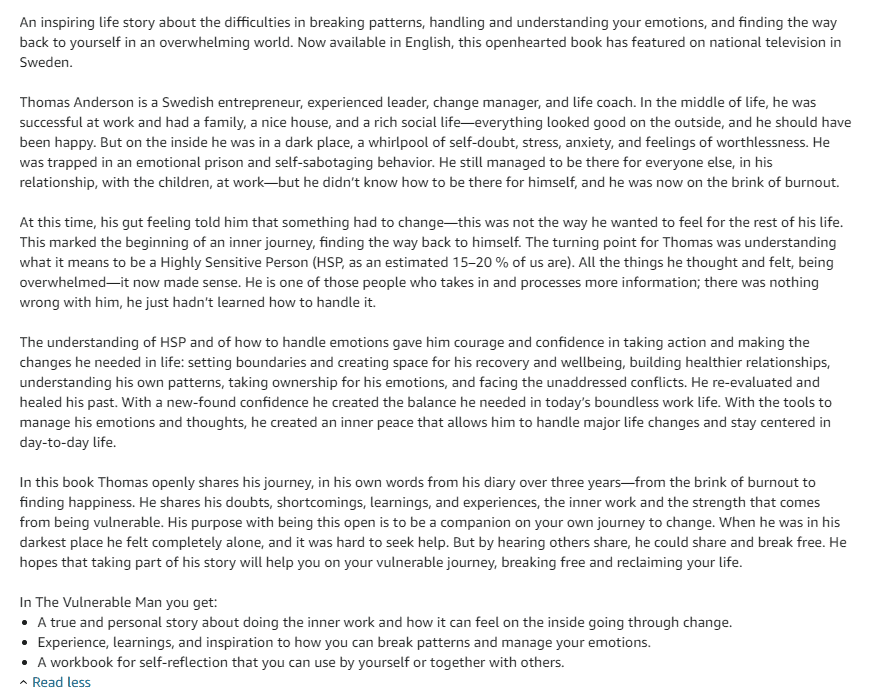
What Makes it a Bad Book Description
- This description doesn’t make the book’s main idea or message clear. It talks about how hard it is to break old habits and find your way back to yourself, but it’s not clear right away what the book is about or what readers can expect to learn from it
- This description is pretty long, which could be too much for some readers. It talks a lot about the author’s life and experiences, which may be interesting but may also take away from the book’s main points
- It doesn’t have any convincing language and it also doesn’t say what benefits or results people can expect from reading it. This could make it harder for people to figure out what the book is worth and why they should spend their time and money on it
#2 Keto Diet for Weight Loss by James Armstrong

What Makes it a Bad Book Description
- The description doesn’t say anything about the author’s qualifications or experience in the field. This could make it harder for readers to figure out how trustworthy the book is
- The description puts a lot of emphasis on the benefits of the ketogenic diet and may not give a balanced picture of the possible downsides or risks of this approach
- The description doesn’t say what specific goals or results readers can expect to get from following the diet and tips in the book, which may make it harder for readers to understand how the book can help them
- Lastly, the description doesn’t say anything about the book’s format or length, like how many chapters or recipes it has, which may be important to some readers
- Lastly, the description doesn’t follow any pattern. You can see random words being “bold” and irregular font sizes
#3 Poor Man’s Cookbook by C Gibson

What Makes it a Bad Book Description
- The description is short and doesn’t say much about the recipes or ingredients in the book
- The description doesn’t make it clear what the book’s main idea or purpose is, like why the recipes are easy to make or how they are made for people on a budget
- The description doesn’t say anything about the author’s qualifications or experience in cooking or budgeting, which may make it hard for readers to decide if the book is reliable
- In the description, it says that the book is not about healthy recipes, which may turn off some readers who are looking for healthy meal ideas
- The description doesn’t say anything about the book’s format or length, like how many chapters or recipes it has, which may be important to some readers
#4 The Summer We Forgot by Caroline George
What Makes It A Bad Description
- The summary isn’t clear or concise about the story’s plot or main conflict, which could make it hard for readers to understand what the book is about
- There is a lot of vague or general language in the description, like “lush, evocative prose” and “memories are better left forgotten,” which may not be specific or interesting enough to catch readers’ attention
- The description doesn’t say anything about the characters or what makes them act the way they do. This could make it harder for readers to connect with or care about the story
- There are a lot of technical details in the description, like how long the book is and whether or not it has discussion questions, which may not be important or interesting to all readers
#5 I Wish I Were a SEAHORSE by Dan Jackson

What Makes it a Bad Book Description
- The opening and closing lines are decent; everything else is not!
- The middle section must have been about the book. You know, what it’s about, etc. But, instead of that, the author preferred to showcase some customer reviews (which, by the way, are illegal according to Amazon) in a pretty weird way
- Those microscopic words do explain a little bit about the book, and honestly, those are catchy lines but wait, what? Did I read the “pregnant” word? This book is for kids, right?
- To summarize, huge, unrealistic fonts, an irrelevant middle section, and something about pregnancy… These are all things you should never do in a book description
How To Write An Amazon Book Description With Description Generators
You need your book description to be equally informative and visually appealing. Otherwise, it won’t bring enough sales. And to write the best Amazon book description, you should consider taking help from related tools.
According to research, nearly 90% of content marketers use some kind of digital tool to grow their business. So why should you stay behind? Here are the best Amazon Description Generating tools in the market:
- Non-AI Tools
- Kindleprenuer Amazon Book Description Generator
- PublishWide Amazon Kindle Blurb Description Generator
- AI Tools
- ChatGPT
- JasperAI
#1. With Kindleprenuer Description Generator
Here is the step-by-step tutorial on how to use Kindleprenuer Description Generator to format your book description in a compelling way:
- Go to Kindlerenuer Amazon Description Generator
- Use the tool’s formatting features to properly format your description and make it visually appealing
- Once done, generate the HTML code by clicking on the “Generate My Code” button
- Copy the code and paste it into Amazon Kindle’s “Write Your Book Description” tab
- You’re done
Here is how the output will look (I’ll take Douglas Rushkoff’s Coercion description as an example):

You can use this tool to generate book descriptions for other platforms like Barnes & Noble. So, before you generate a description for your Amazon book, make sure you’ve selected the “Amazon Book Description” tab.
#2. With ChatGPT
While Kindleprenuer’s tool only lets you format your book description, ChatGPT can write the whole description for you if you give it the plot of your book. Here is what you need to do:
- Head over to ChatGPT
- Sign up with your OpenAI account (Don’t have one? Just sign up on OpenAI)
- A window will appear with a chatbox below. Ask it to write a book description for your book while explaining the whole plot
- TIP: Be a lot more specific while giving instructions
- Copy the generated description and paste it into the Amazon Kindle’s “Description” tab
Here is how the output will look (I’ll input imaginary details):

There is one pitfall, though. You can’t properly format your description with ChatGPT. But hey, we’ve Kindleprenuer’s description-formatting tool for that! See how lethal this combination can be?
More Things To Consider with Amazon Book Descriptions
You’ve learned almost everything about how to write a book description that generates sales. But it doesn’t hurt to be extra vigilant, right? Here are some other considerations (or tips) you should keep in mind to craft a compelling description for your book.
1. Use AIDA Technique
The AIDA technique is a marketing method that aims to grab the attention of potential customers, generate interest in a product or service, create a desire to purchase, and prompt action.
To use AIDA effectively in your book description;
- Start by capturing the reader’s attention with an engaging headline or opening sentence;
- Next, highlight the key features and benefits of your book to pique the reader’s interest;
- Create a desire to purchase by highlighting the value your book will bring to the reader’s life;
- Finally, encourage action by providing a clear call-to-action, such as “click here to purchase now.”
Here is an example:
2. Properly Format Your Description
First, formatting your book description can greatly improve its effectiveness. Using bold, bullet points, italics, and icons can help draw readers’ attention to key points and make the description more visually appealing.
When formatting your description, be sure to use these tools sparingly and strategically to enhance rather than distract from your message. There are several formatting options available on Amazon KDP, including the ability to:
- Bold text
- Italicize text
- Create bulleted lists
- Add headings
- Insert hyperlinks
- Use emoji or icons

The book description of Tim Ferris’ 4-Hour Work Week is a great example of properly formatted description:

The perfect use of “bold”, “Italics”, and “bullet points” features
On the other hand, Douglas Rushkoff’s Why We Listen to What “They” Say has a poorly written Amazon description:

He didn’t even use the “bullet points” feature. A poorly formatted or poorly optimized book description with long walls of text and/or stuffed with keywords may lead to poor sales, a lower search ranking, low reader engagement, and negative reviews.
To avoid these pitfalls, write a well-written, concise, and optimized book description that accurately represents the content of your book and persuades readers to purchase. Avoid using excessive keyword stuffing and use formatting tools to make the description visually appealing and easy to read.
3. Keep Character Limit Sweet and Short
No matter how good your description is, if it is a long wall of text, people ain’t gonna read it. You know how short the attention span of readers has become!
Also, long descriptions lose clarity along the way and it’s also a nightmare for people to digest. So, what you should do is keep the character limit of your description sweet and short. My recommendation?
Keep it between 200-300 words. The good descriptions I shared above all have a good amount of words that don’t scare people away. Take inspiration from them.
4. Use the Art of Copywriting
The art of copywriting is also crucial when it comes to writing a book description. In addition to presenting the key features and benefits of your book, you’ll want to use persuasive language that compels readers to take action.
This is where “power words” come in – words that are particularly effective at evoking emotion and influencing buying decisions. Some examples of power words include “free,” “new,” “guaranteed,” and “limited time.”
By using powerful words and crafting a well-written, compelling book copy, you can increase the chances of your book standing out on Amazon. If you look closely, Tim Ferris also used several powerful words in his book “The 4-Hour Work Week’s” description. I’ll highlight a few:
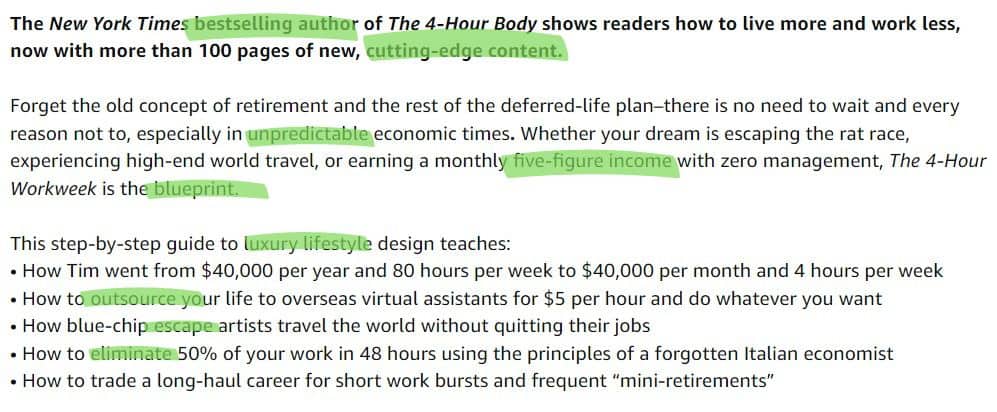
Rules Of Amazon Book Descriptions
Yep, Amazon won’t let you write just anything in your book description. There are some strict guidelines that you must follow otherwise, Amazon will reject your book description or in worst-case scenarios, de-list your book.
Here are Amazon’s description requirements written in simple words:
- Material that is sexual or explicit in nature
- Any type of contact information
- Reviews from readers (though I’ve seen many authors getting away with this)
- Asking customers to leave a review
- Any promotional material
- Information that is time-sensitive, such as dates for events or tours
- Quoting any other website to place orders
- Any spoiler information (about your book or others’)
- Emojis
- Overly stuffing with keywords
The last one is the most important. Throughout my self-publishing journey, I’ve seen indie authors making the same mistake over and over again, especially beginners. No, you don’t need to use your genre and topic in each sentence of your description. It can appear spammy.
Your Amazon book description must read naturally as possible, even after optimizing with keywords.
Advanced Tips For Selling More Copies With Your Book Copy
You want to make money with your book on Amazon, right? Then focus on these advanced considerations. First, run ad campaigns with short descriptions or copy.
When running an Ad Campaign, you’ll typically have limited space to include the copy so you must focus on the key features and benefits right out of the bat. And, try to use persuasive language to boost conversions.
Here is a pro tip: maximize the effectiveness of your book copy on Amazon through A/B testing. This involves creating two versions of your book description and testing them against each other to see which one performs better.
I’ve used this strategy extensively in my self-publishing journey on Amazon. I’d use an “A” description for a month and then a “B” description for the next month and analyze the conversion rate. Finally, I’d end up going with the description with the highest conversion (you don’t become a 7-figure self-publishing author on Amazon for nothing!”
In addition to A/B testing, it’s also a good idea to track your sales and metrics over time to see how your book copy is performing. This can help you identify any areas for improvement and make adjustments to your book description as needed.
Alternatives to Writing A Good Book Description
Don’t feel like writing a book description? Or do you think you don’t have enough copywriting capabilities? Or already tried several book descriptions but none seem to work? I’ll share some tips on how to get a good book description written even if you have no idea how to write one.
1. Hire from UpWork or ProBlogger
UpWork is a freelance marketplace from where you can hire a copywriter to do the job for you.
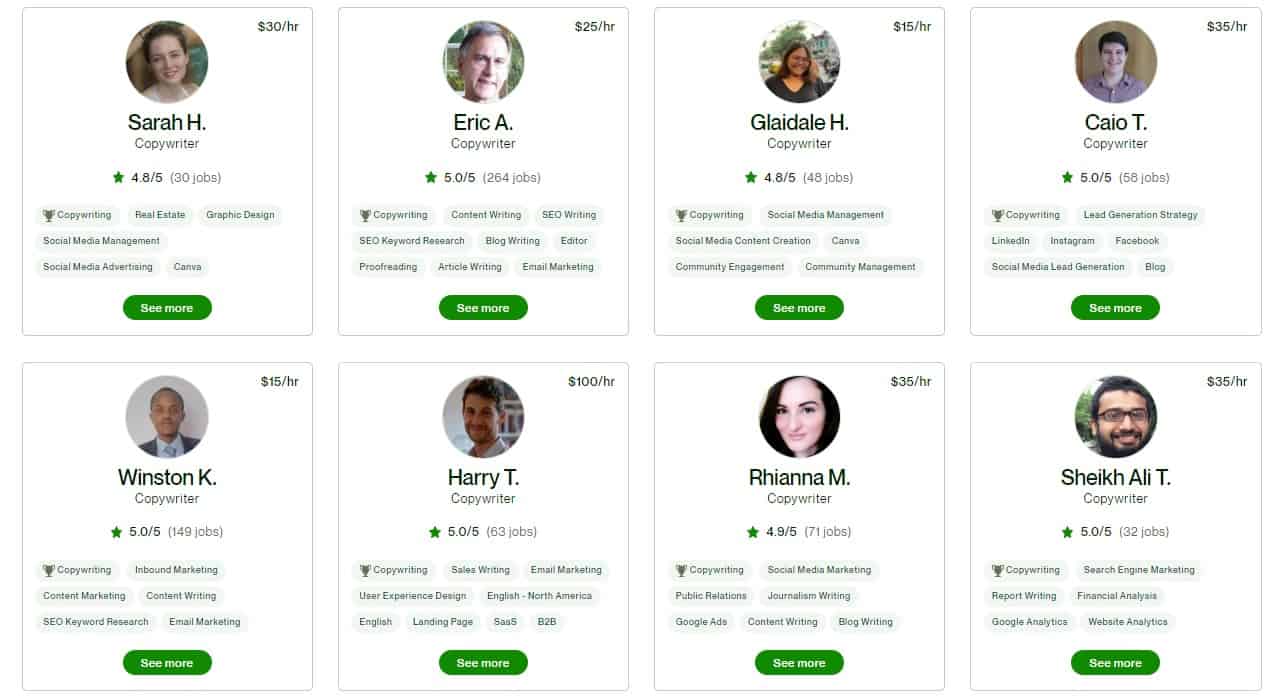
On the other hand, ProBlogger is a job board where you can post a job, hire a copywriter, and let him/her write the book description.
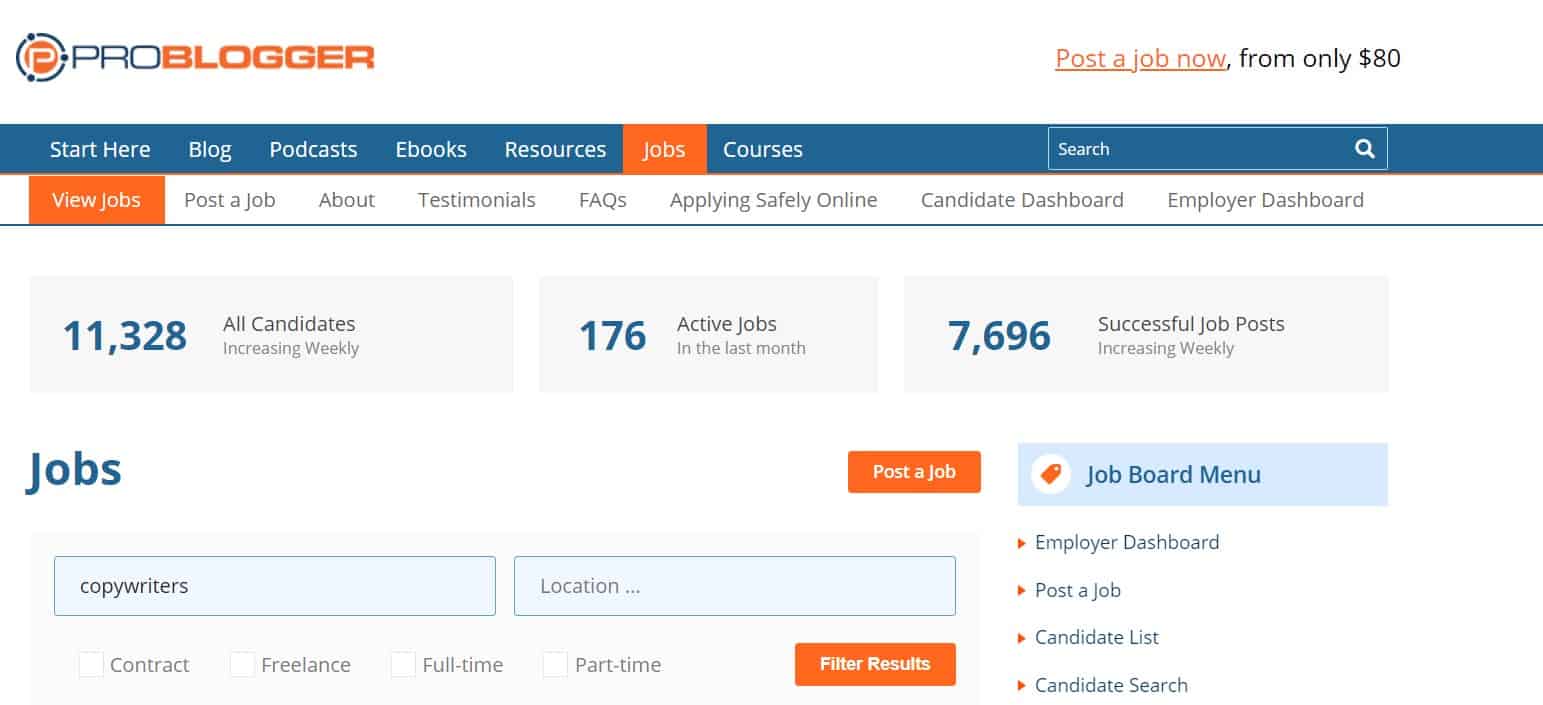
2. Hire a Writing Agency
You can also hire a writing agency to write the book description. I recommend you go with the Writing Studio out of all the writing agencies out there.

3. Take Help from Publishing Companies
Finally, there are several publishing companies out there that can assist you with anything from writing an ebook from scratch to providing editorial services. Here are a few companies you can take help from:
Wrapping Up
It might seem hard to write an Amazon book description that sells, but it doesn’t have to be. Use the tips and techniques in this blog post, so you can write a description that convinces readers to buy.
Remember to identify your target audience, use persuasive language, and include all of the important details in your description. You can increase the visibility and sales of your book on Amazon with a little effort and the right approach.
Begin implementing these strategies today and watch your book reach a larger audience and climb the Amazon sales ranks.


